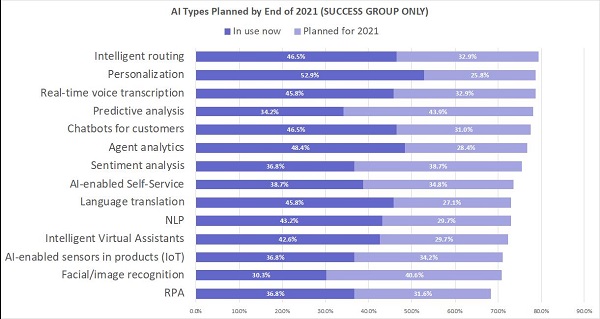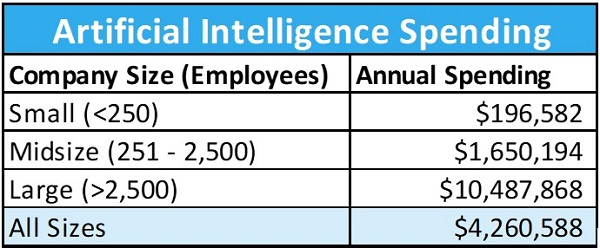The use or planned use of artificial intelligence (AI) for customer experience (CX) initiatives has grown by 60.5% in just two years. An effective AI strategy has become essential to delivering competitive customer service.
The challenge is customizing a well-funded strategy to leverage the types of AI that will result in measurable business success. That’s why, when building a strategy, it’s imperative to carefully consider these three key questions:
- What types of AI are most effective in delivering optimal customer interactions that address specific business goals?
- What is a reasonable amount of spending for AI?
- How are companies measuring success, and what levels of success have they already realized?
In Metrigy’s “2020-21Customer Engagement Transformation” research study, we identified a success group, which included companies that documented high levels of before-and-after improvement in revenue, cost, customer ratings, and agent efficiency in their CX transformation projects. Here is a look at what these successful organizations are doing.
Leading AI Applications
Organizations can use dozens of AI-enabled applications, backed by machine learning knowledge bases. These applications include voice transcription, language translation, natural language processing, sentiment analysis, and virtual assistants. (See figure below for a list of AI applications successful companies are using for CX).
In order to determine which AI applications are best for your organization, consider the business goals you’re trying to achieve. For example, success group companies that have rapidly adopted AI-assisted intelligent routing are seeing a 42.3% boost in CSAT. As of the end of 2020, 46.5% of our research success group was using AI-assisted intelligent routing, and another 32.9% were planning to do so in 2021.
With AI-assisted intelligent routing, a machine learning knowledge base continuously updates agent performance on numerous metrics, such as first call response (FCR), ability to handle specific types of inquiries, post-call survey, availability, and even customer history or satisfaction of customers with similar issues. By asking a customer the reason for the interaction, AI can route the call to the best possible agent at that second for the issue at hand.
Organizations trying to reduce operational costs in the contact center have been implementing real-time voice transcription: 45.8% had implemented this in 2020 (and found a 13.6% reduction in cost) with another 32.9% planning for 2021. The value with transcription is that agents don’t have to take notes and note follow-up items after each call, saving significant time (estimates range from two to 10 minutes, depending on the complexity of the call). AI transcribes each call, and by using keywords, AI can highlight or color-code action items automatically.
Moving into 2021, the fastest-growth areas among the success group are:
- Predictive analysis (43.9%) – Predictive analysis helps all metrics. For example, it drives revenue by predicting customers’ buying habits. When paired with self-service or e-commerce, it recommends complementary products, warranties, or monthly shipments based on the customer’s profile or on those similar to that customer. For agents, predictive analysis (often coupled with natural language processing) can deliver screen pops to provide agents with suggestions.
- Facial/image recognition (40.6%) – This is helping significantly with customer satisfaction among those using it. Facial recognition is picking up steam now as contact centers are adding video as an interaction channel. (Video grew by 15.6% from 2019 to 2020.) Rather than running through a list of three or four security questions on every video call, facial recognition eliminates that annoyance for customers (albeit one that protects their identity) and shaves time off calls.
- Sentiment analysis (38.7%) – Also driven by more virtual interactions, CX leaders want to gauge the customers’ mood, level of satisfaction, and level of frustration on voice, video, and digital interactions. Based on their sentiment and the associated recommendations, agents have authority to take actions — escalate to a supervisor, offer a discount, or invite them to a loyalty program.
- AI-enabled self-service (34.8%) – As the load on contact centers continues to grow, CX leaders are trying to use self-service knowledge bases to deflect appropriate live-agent interactions. They’re updating knowledge bases to include more appealing, multimedia contact — and then pairing them with virtual assistants that can guide customers to the information they need, take an action, or escalate to a live agent.
AI Spending
All of these AI applications may appear on a technologist’s wish list. But then the financial realities set in. Fortunately, spending on AI is increasing. In 2021, 59.1% of all research participants plan to increase their AI spending by an average of 26.7%. The research success group plans to increase spending even more, by 33.2%.
The actual dollar amount depends on the planned projects. For example, retooling an entire self-service knowledge base and pairing it with a virtual assistant is more costly than implementing a basic chatbot to provide routine information like overnight mailing addresses.
Our research shows the average annual spending on AI technology for all participants, across all company sizes, is $4.2 million. However, the difference between the research success group and all others is profound. The success group spends nearly $6 million on AI technology, compared to $927,500 for the non-success group.
Measuring Success
In order to keep the investments alive and well, organizations must rely on a variety of metrics to document their success (or failure). Some focus on contact center key performance indicators (KPIs), such as FCR, call handle time (CHT), and time in queue. Increasingly, though, organizations are more focused on higher-order business metrics, including revenue generation, cost decrease, customer ratings improvement, and agent efficiency boosts. Successful companies look at all these business metrics, with cost reduction slightly more utilized than others.
Actual improvements vary by type of AI application and the metric used. For example, AI-assisted intelligent routing reduces operational costs by 16.2% (the highest of all applications), while sentiment analysis only reduces costs by 2.8% (the lowest). But when evaluating agent efficiency, the results are reversed, with sentiment analysis driving much more value than intelligent routing.
One of the most compelling success metrics from our research is how much AI improves agent efficiency. When companies automate agent functions, they are improving efficiency by 31.1%. This is measured in time, so that equates to about 12 hours per week.
Though we only expect 11.5% of companies to decrease the number of agents in their contact centers in 2021, automation enables existing agents to handle more and it also has meant a reduction in the number of new agents companies had been planning to hire. Because of the growing demand for virtual customer service, 48.7% of companies plan to increase the number of agents in 2021. But the productivity of those agents is amplified with the use of AI-enabled automation.
Overall, it’s important to measure something. Determine at the start of any CX transformation project which metrics you’ll measure. Take a baseline before starting the implementation, and then measure the same metrics on regular intervals for indicators of problems — and document success to keep the support of financial stakeholders.












